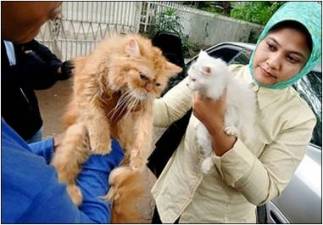H1N1v swine flu jumps species barrier again, infects Iowa housecat
A Reuters story from today underscores just how resilient and unpredictable swine flu really is. A housecat in Iowa was feeling kinda poopy, as were two human members of the household, owned (as everyone knows) by the housecat.
A vet swabbed the housecat and sent the sample off to be tested. Sure enough, the sample came back positive for H1N1v. This marks the first time a cat has been diagnosed with H1N1.
 But felines catching pandemic or potentially pandemic strains of flu is not new. Recall the Bangkok Zoo tigers -- almost 60 in total -- who had to be euthanized because they ate chickens tainted with H5N1 bird flu. Also, in Indonesia, it is estimated that 20% of all cats contain antibodies to H5N1, because they have feasted or nibbled on poultry and wild birds infected with bird flu. H5N1 is still endemic to Indonesia, and a couple of years ago, the Indonesian Army was called upon to actually swab housecats to check for H5N1 antibodies (photo at left).
But felines catching pandemic or potentially pandemic strains of flu is not new. Recall the Bangkok Zoo tigers -- almost 60 in total -- who had to be euthanized because they ate chickens tainted with H5N1 bird flu. Also, in Indonesia, it is estimated that 20% of all cats contain antibodies to H5N1, because they have feasted or nibbled on poultry and wild birds infected with bird flu. H5N1 is still endemic to Indonesia, and a couple of years ago, the Indonesian Army was called upon to actually swab housecats to check for H5N1 antibodies (photo at left).
Bird flu just flared up again in Vietnam, in an area (Diem Bien province) where it had not been seen in several months. Some 3,000 birds were culled to try and prevent its spread, even though bird flu needs to fire its press agent and hire a new one.
Should we be surprised by this latest development? I am not sure. Perhaps this has more to do with bird flu's affinity for the hunter (cats) and, as my recent blog said, sometimes swine flu runs home to Momma, Momma being the 1/3 avian origin of this unique hybrid pandemic virus. So I am not surprised that H1N1v would jump the species barrier again. Nothing about this virus surprises me anymore.
Dogs are another matter. H3N8 equine influenza crossed the species barrier to dogs in Florida sometime in the past 10 years, but there are no signs that dogs have caught swine flu. There are signs, however, that dogs have caught H5N1 bird flu. In my blog, "Beware of Dog" gains new meaning, I talk about the Dutch experiment regarding H5N1. Dogs can, indeed, catch avian flu. So it would not be surprising, then, if Fido or Buster caught swine flu.
If you read the aforementioned blog, from 2007, it indicates H5N1 droplet nuclei were present and active in dogs' nasal secretions. There are some instances of H3N8 canine influenza in this country right now. Is dual infection likely or unlikely? A lot of people will be boarding their dogs and cats as the holidays approach. I would not be surprised if we see some canine H1N1v infections confirmed, nor would I be surprised if we see a dual infection or two.
This pets-with-swine flu development does potentially complicate things. It means that surveillance needs to take on additional forms, particularly overseas in Asia where dual H5/H1v infections could occur. It means additional "mixing vessels" where avian flu and swine flu could reassort and emerge, infecting pigs, birds and, potentially, people. Surveillance has failed us once this decade, as public and animal health experts were so focused on swabbing birds' asses in the search for H5 that they missed the H1 swine flu pandemic that was brewing right under their noses. What makes matters worse is the grossly underreported fact that swine flu happens in this nation all the time.
So let's alert the vets of America to this new wrinkle, and let's do a little surveillance to see if cats and dogs are bringing their masters more than just dead birds and old shoes.

Reader Comments (2)
If swine pandemic H1N1 is said to easily out-compete the seasonal flu strains, then maybe it could out-compete H5N1.
Whoa. The cure for the H5N1 epidemic might be the swine flu epidemic.
sorry. That last word should be "pandemic."